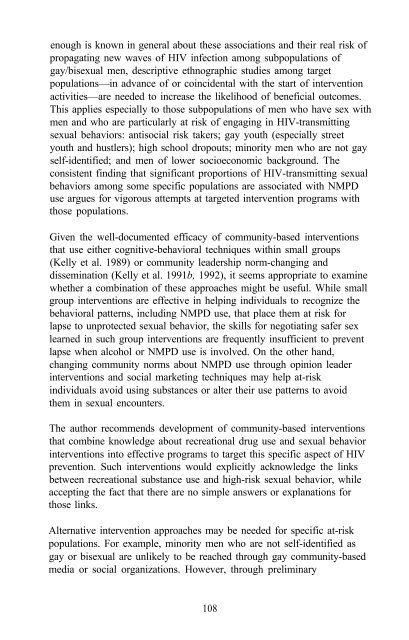The Context of HIV Risk Among Drug Users and Their Sexual Partners
The Context of HIV Risk Among Drug Users and Their Sexual Partners
The Context of HIV Risk Among Drug Users and Their Sexual Partners
You also want an ePaper? Increase the reach of your titles
YUMPU automatically turns print PDFs into web optimized ePapers that Google loves.
enough is known in general about these associations <strong>and</strong> their real risk <strong>of</strong><br />
propagating new waves <strong>of</strong> <strong>HIV</strong> infection among subpopulations <strong>of</strong><br />
gay/bisexual men, descriptive ethnographic studies among target<br />
populations—in advance <strong>of</strong> or coincidental with the start <strong>of</strong> intervention<br />
activities—are needed to increase the likelihood <strong>of</strong> beneficial outcomes.<br />
This applies especially to those subpopulations <strong>of</strong> men who have sex with<br />
men <strong>and</strong> who are particularly at risk <strong>of</strong> engaging in <strong>HIV</strong>-transmitting<br />
sexual behaviors: antisocial risk takers; gay youth (especially street<br />
youth <strong>and</strong> hustlers); high school dropouts; minority men who are not gay<br />
self-identified; <strong>and</strong> men <strong>of</strong> lower socioeconomic background. <strong>The</strong><br />
consistent finding that significant proportions <strong>of</strong> <strong>HIV</strong>-transmitting sexual<br />
behaviors among some specific populations are associated with NMPD<br />
use argues for vigorous attempts at targeted intervention programs with<br />
those populations.<br />
Given the well-documented efficacy <strong>of</strong> community-based interventions<br />
that use either cognitive-behavioral techniques within small groups<br />
(Kelly et al. 1989) or community leadership norm-changing <strong>and</strong><br />
dissemination (Kelly et al. 1991b, 1992), it seems appropriate to examine<br />
whether a combination <strong>of</strong> these approaches might be useful. While small<br />
group interventions are effective in helping individuals to recognize the<br />
behavioral patterns, including NMPD use, that place them at risk for<br />
lapse to unprotected sexual behavior, the skills for negotiating safer sex<br />
learned in such group interventions are frequently insufficient to prevent<br />
lapse when alcohol or NMPD use is involved. On the other h<strong>and</strong>,<br />
changing community norms about NMPD use through opinion leader<br />
interventions <strong>and</strong> social marketing techniques may help at-risk<br />
individuals avoid using substances or alter their use patterns to avoid<br />
them in sexual encounters.<br />
<strong>The</strong> author recommends development <strong>of</strong> community-based interventions<br />
that combine knowledge about recreational drug use <strong>and</strong> sexual behavior<br />
interventions into effective programs to target this specific aspect <strong>of</strong> <strong>HIV</strong><br />
prevention. Such interventions would explicitly acknowledge the links<br />
between recreational substance use <strong>and</strong> high-risk sexual behavior, while<br />
accepting the fact that there are no simple answers or explanations for<br />
those links.<br />
Alternative intervention approaches may be needed for specific at-risk<br />
populations. For example, minority men who are not self-identified as<br />
gay or bisexual are unlikely to be reached through gay community-based<br />
media or social organizations. However, through preliminary<br />
108
















